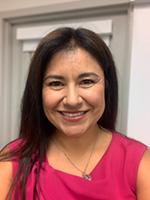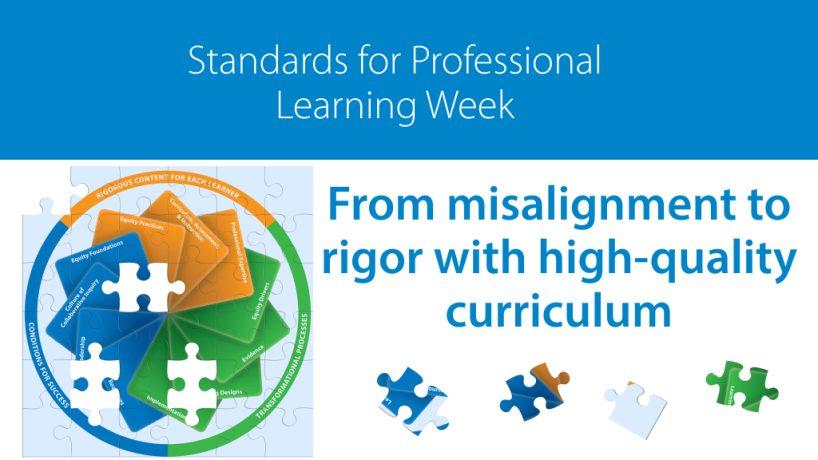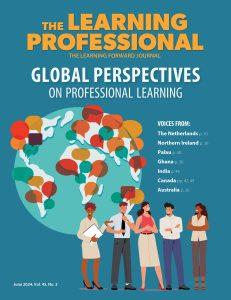Nearly one year into their engagement in a Learning Forward Curriculum-Based Professional Learning network, educators from Montgomery County Public Schools are poised to describe their promising new practices supporting curriculum-based professional learning and showcase early improvements they’re seeing for both educators and students.
Three educators from the Maryland district recently joined a Standards for Professional Learning Week 2024 forum to share details from their experiences of participating in the CBPL improvement network and implementing Illustrative Mathematics with integrity at the middle-school classroom level. The Standards Week session, Shifting from misalignment to rigor with high-quality curriculum and instructional materials, was facilitated by Learning Forward’s Elizabeth Foster, senior vice president of research and strategy. The full session recording is here.
Jennifer Loznak, supervisor for secondary math in Montgomery County Public Schools, said four instructional math coaches were hired at the outset of the 2023-24 school year to provide teachers at 14 middle schools with the day-to-day support they needed to unpack high-quality instructional materials and implement Illustrative Mathematics with integrity. The new coaches and other high-quality professional learning strategies are paying off. Loznak explained how the changes in teacher practice are contributing to an increase in district assessment data and in MAP scores assessing student growth.
The district transitioned to Illustrative Mathematics during the pandemic and recognized implementation was inconsistent from school to school. Loznak described the misalignment: “I fully believe there’s a written curriculum, a taught curriculum, a learned and an assessed curriculum. We aligned our written curriculum and assessed curriculum. But what teachers were teaching wasn’t always aligned to the written curriculum. And what the students were actually taking away from that taught curriculum, which is what they learned, wasn’t always aligned. So we weren’t going to see the results that we wanted on that assessed curriculum because there wasn’t alignment.”

Jennifer Loznak, Montgomery County Public Schools
Coaching strengthens capacity
Jacque Mariott is one of four instructional math coaches hired this year to support the middle-school math teachers. She said the team was able to receive just a few months of strong instruction on Illustrative Mathematics before the district switched to remote teaching. Now, Mariott said, “we’re trying to get back into the groove of applying this in a more integrated way across our district.” She cited Shady Grove Middle School as one that is “just blowing it out of the park. All of their teachers are on board; all of their different classes on grade level and in advanced are doing amazing things, because our teachers have fully bought into the work.”

Jacque Mariott, Montgomery County Public Schools
Malaika Stewart, math content specialist at Shady Grove, has taught math at the middle-school level for 27 years. She admitted apprehension about getting a new coach, but “Jacque came in and helped us see some of the things in the curriculum that we didn’t even know were there. Now that we have been exposed to new things, the kids are really catching on.”
Stewart said math language routines are pivotal part of helping all students build academic language and confidence in math. “We have a high ESOL (English Speakers of Other Languages) population in our school, so those routines are valuable, not just for those students, but for all the students. When students get used to a process of how to attack problems, it helps them to gain confidence.”
Learning Forward shared a math language routine resource with webinar attendees who asked to know more. The white paper explains the framework included in Illustrative Mathematics that “helps teachers address the specialized academic language demands in math” (Zweirs et. al, 2017).
Mariott said from a coaching perspective, another significant professional learning shift was setting a PLC goal for schools in the network based on an instructional practice that teachers in the PLC wanted to embrace and work toward together. “Anytime I’m with a PLC planning for how student learning is going to happen, I bring them back to what their goal is as a group to grow.”
Measuring impact
Loznak said the district is conducting an implementation evaluation on the new curriculum-based professional learning initiative. The educators are using practical measures – quick, low-burden ways of collecting data as part of their day-to-day work – to study how their changes in instruction are impacting the “cooldowns” that are part of Illustrative Mathematics and designed to help students synthesize the day’s learning. At the same time, they are tracking district and school assessment data, and are in early stages of comparing data from schools with coaches to those without coaches.
To learn more about how the work in the CBPL Network is measured, read the recent article in The Learning Professional, “Practical measures tell us if change is making a difference,” by authors Michelle Bowman and Nick Morgan, which describes the practical measures in use by the CBPL district members to capture aspects of teaching and learning in 6th- to 8th-grade math and algebra.
“Helping teachers to understand what’s in the curriculum has helped the students to thrive in that environment, which is something that they weren’t used to at all,” Malaika Stewart said. “It didn’t happen overnight, but over time they (students) developed the skills. Now it’s just like second nature to them. When the kids are more confident, they’ll talk about it more, they’ll share more, and you’ll see their scores go up, and that’s exactly what’s happening.”







